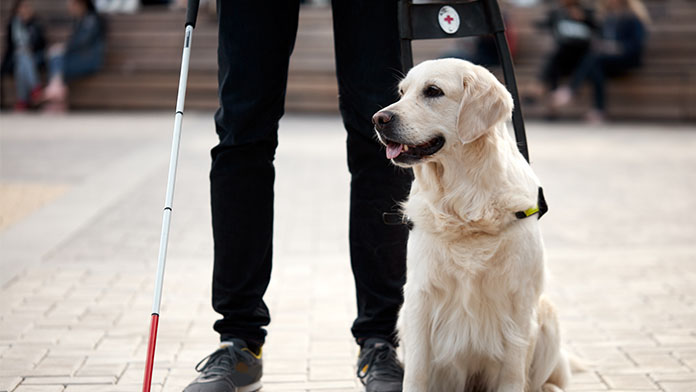It is considered man’s best friend, but for a blind person the dog can represent much more, it can be a precious support in daily activities. However, a precise path, about two years long, is needed to train a guide dog.
«First of all it must be said that the most predisposed breeds for this role are the Golden Retriever and the Labradorparticularly sociable dogs,” he explains Corrado Migliorucci, technical manager of the National School for Guide Dogs for the Blind of the Tuscany Region, located in Scandicci, in the province of Florence. «The first step is entrustment to a family. At the age of two months, the puppy is entrusted to the so-called puppy walkervolunteer adoptive parents, with whom, during a year-long socialization program, he learns how to live in a family, how to behave in a house, how to get around in a city. He must get used to all situations of everyday life: walking in traffic, traveling on public transport, riding escalators and elevators, going to the beach and mountains.
In the first months of his life, the dog is curious, so it is important that he has many experiences during that period. The puppy walkers, who obviously have to be animal lovers, receive no compensation, but they don’t even have expenses: they are all paid for by the training school».
The first training as a puppy
After this first phase, at an age ranging from one year and two months to one and a half years, the four-legged is taken over from the school, where a qualified instructor tests its temperament and abilities. «For six months», continues the expert, «the dog follows daily lessons for learn to move well in contexts that present pitfalls and obstacles, such as sidewalks obstructed by poles, cars or road works, to walk in crowded areas without bumping into passers-by, not to get annoyed by noise, to point out the steps. The animal becomes a guide for the blind only if it is able to deal with all this in the correct way».
Two weeks to check the harmony
The third and final phase, the most delicate, concerns the pairing of the dog with the blind person. “The four-legged friend and his designated partner stay together for a couple of weeks in the training school,” explains Migliorucci. «During this period the instructor walks with the dog and the potential assignee, understanding from their way of interacting if there may be affinity. For example, a slow-moving person and a lively animal are not so compatible. In any case, for guidance, the blind person must have good mobility orientationbecause in everyday situations it is he who has to determine, for example, when to cross the street.
Contrary to a fairly widespread thought, the dog lacks the ability to identify whether a traffic light is red or green, but limits itself to guiding the master to reach the other side of the road, avoiding that he runs into danger: he sees any obstacles and makes him avoid them. If the affinity is the right one, the animal is granted free of charge to the blind (the training schools are supported thanks to public and private contributions), who only have to bear the costs of maintenance: food, hygiene and veterinary expenses.
The rules of behavior
The law allows the blind to enter all public places with their own four-legged friend and to get on public transport without having to pay for the ticket. The guide dog is recognizable because it has a special harness, with a handle on the back, held by the master. Sometimes you can meet one on the street or in a public place. In that case it is important to respect some rules of good behavior towards him: do not offer him food, do not call him and do not distract him with whistles while he works. If you want to pet it, you should ask the blind person for permission.
And if you have a dog, it’s best not to let it off the leash near a working guide dog, even if the latter is trained to ignore surrounding distractions and focus on its owner’s needs.
Last but not least, it is worth dwelling on the aspect of animal welfare. “The guide dog, once assigned to the blind, it must be cared for, fed, cleaned and suitable accommodation must be reserved for him», points out the expert. “Of course, if the carer lives with other family members, everything becomes easier. The dog also needs a moment of relief every day. He should be let loose in a park at least once a day, so that he can run and have fun ».
The guide dog remains in service for about ten years
Beyond concrete help, the company of a guide dog gives well-being, reduces anxiety and loneliness. But sooner or later the time for his well-deserved “retirement” also arrives. Generally the length of his career is eight to ten yearsafter which he is replaced by a new younger draft.
«The best solution for a retired dog is to stay and live with the foster person, in an environment that he already knows and in which he has spent most of his life», concludes Migliorucci. “We ensure that, once they grow old, they are not locked up in a kennel. That would be cruel, after having worked all your life. If the blind person cannot keep it, we take it back. After all, legally the guide dog always remains the property of the school, which can take it back at any time if it is not treated with respect”.
The three schools in Italy
There are three Italian schools for official guide dogs, affiliated to the International Federation:
- the National School for Guide Dogs for the Blind of Scandicci (Florence);
- the Helen Keller Regional Center of the Italian Union of the Blind and Visually Impaired in Messina;
- the Service dog guide of the Lions of Limbiate (Monza and Brianza).
The first two centers are public, the third is private, but they all provide guide dogs free of charge to blind people who request them. The oldest school is that of Scandicci, founded in 1929 by the Italian Union of the Blind and since 1979 it has been a service of the Tuscany Region.

